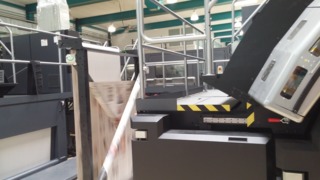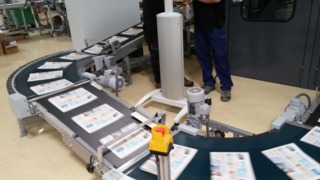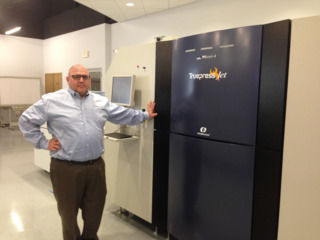Can Production Inkjet Presses Work for the Newspaper Industry?
Industry experts agree the driving factors behind newspapers being printed on production inkjet devices are more efficient shorter runs and targeted audiences.

Rodd Winscott, president and general manager of TopWebb in Chicago, IL, considers press runs when choosing a press for printing. TopWebb’s offset presses can run 75,000 copies an hour. Its digital presses run slower.
But while it’s not cost-effective to run a 15,000-copy job on the inkjet, it is to do 5,000 copies, noted Winscott
TopWebb is a 43-year-old commercial printing firm specializing in small- to medium-sized newspapers such as campus and ethnic newspapers and journals. The company has two cold web offset presses and two digital web presses – the TKS JetLeader 1500 – purchased in 2012 and 2013.
TopWebb was the first company to start producing exclusively newspapers on its digital equipment, Winscott noted. The concept was well-received by clients. A three-year ROI was attained.
The idea is gaining traction. Hawaii-based Japanese newspaper publisher Hawaii Hochi prints on a TKS JetLeader1500.
Recently, Mengis Druck AG in Visp, Switzerland was the first worldwide to print a daily newspaper on an inkjet press – the 42-inch wide HP T400 Color Inkjet Web Press – at a 22,000 run length.
Winscott said the practice will move forward as machines become more competitive through increased speed and web width.
Winscott’s company incorporated digital presses six years ago after publishers affected by the recession cut back on the number of copies printed on offset, resulting in escalating waste.
TopWebb now prints four daily newspapers and a few dozen different weekly jobs on both of its digital machines, said Winscott. The vast majority is ex-patriot media, such as the Chinese World Journal and the Korea Times.
Ex-pats offer a strong readership demographic “because they are avid readers. Newspapers are one of the places they can find news in their language meaningful for them at the national and local level,” noted Winscott, adding some papers are complemented with English translations to accommodate younger generations.
Industry experts agree the driving factors behind newspapers being printed on production inkjet devices are more efficient shorter runs and targeted audiences, primarily ex-pats.
Marco Boer, vice president of IT Strategies, pointed out production inkjet printers are not commonly used for newspaper printing “mainly because the burst volumes on newspapers even today are so great that you need massive capacity for four hours a day followed by 20 hours of idle time.”
Many sites worldwide are working around this issue, he added. That’s due to the ex-pat preference for news in paper format for which they are willing to pay and regional papers microzone ad space to try to displace dollars going to direct mail, Boer said.
Printing a daily newspaper on a high speed inkjet web press device has been the “holy grail” for the 10 years Pat McGrew, ‘HP InkJet Evangelist’, has been working with the press, she noted.
While files could be sent via computer to other locales to be printed, “the challenge was finding the partners willing to do the press time for the ex-pat newspaper because their presses were full printing their own newspapers and the cost of the set-up and licensing agreements was tough, McGrew said.
Only in recent times has there been the ability to “have a device fast enough to meet the daily run length, sufficient image quality to keep advertisers happy and the price point cost per page sufficient for the business model,” said McGrew.
McGraw concurs with other industry experts that it’s the ex-pat business keeping those presses active against the backdrop of the surge of online media. Another use for the inkjet presses is printing localized inserts into large newspapers.
“A neighborhood section, instead of being printed on the big press where it’s not really as easy to get a small segment of 50,000 papers printed and inserted, can be put on a high-speed inkjet web press because the price is in line with what publishers want to pay versus what it would take to do newsprint on a toner-based device or some sort of smaller offset press,” said McGrew. “The neighborhood-based advertising available supports the effort.”
In the US, a declining readership and subscriber base “doesn’t give a publisher a lot of resources to try to reinvent the wheel,” noted McGrew, adding that in Europe, print runs are not the same as that of large US metropolitan dailies, “so they’re working with a different scale”.
Case in point: Italy’s Centro Stampa Quotidiani, owned by a consortium of five national newspaper dailies, uses an HP inkjet web press, the company produces neighborhood and village-based inserts into the large dailies, as well as a newspaper-based product that promotes special events. The cost to put a low run on large offset presses was too prohibitive.
Aron Allenson, sales support Specialist, high speed ink jet for Screen USA, says the company’s equipment is running abroad, but not domestically. He attributes that to finishing.
“They’re running wider webs of 35- or 38-inch webs; they run multi-web presses like a Goss or Heidelberg press,” he said. “These presses have in-line finishing lines that work for the paper the same way they’ve done it since the inception of the paper. You get tabloid and a standard fold-over paper. When you can’t print as wide a web as that, then you start looking at a different format of a finished product.”
Michael Poulin, Sr., marketing manager for Canon Solutions America, noted a strategic move to high-speed production inkjet that not only allows editors to create short run, multi-version papers but offer flexibility in demand changes.
Canon Solutions America offers continuous feed and cut sheet production inkjet machines. The Océ ImageStream 3500 offers high-quality, speedy output on standard offset papers, Poulin said, adding the company also offers a designer’s guide to preparing files.
Inkjet’s high productivity, low costs, small footprint and short-run targeted applications allow newspapers to be produced in streamlined automation in a more cost-effective manner by one person in contrast to the several skilled laborers required for a full-size offset press, he adds.
Allenson added: “There are no plates to load; ink is simpler to replenish. There no blankets to wash up. All cleaning is done with a finger pressing a touchscreen console. Once set up, all finishing is automated.”
In addition to personalized advertising, Allenson outlines other benefits offered by production inkjet devices:
- Shorter run is more economical; cross over can be determined based on a newspaper’s existing equipment
- With digital, there is no negative economic impact to multiple versions
- If the news changes part way through a run, the rest of the run can be updated with a file change
- Marketers can choose between full color or black only adverts and pay the difference; there is no need to be in a certain section of the paper
- Newspaper stands can order papers with coupons for their other products inside the paper
Factors driving the trends include year-over-year circulation decline in the US and Canada by 5.3 percent and advertising revenue declines by 8.7 percent. In contrast, interactive advertising typically generates an increase of 30 percent in revenues.
“Using hybrid technologies where printers can add digital inkjet components to offset web presses is creating a viable price and performance point to affect this application effectively,” said Will Mansfield, director of worldwide sales and marketing – inkjet presses for Kodak’s enterprise inkjet systems division.
“Being able to print unique codes on a newspaper advertisement turns it into an interaction ad, which help drive in-store promotions, discounts, website visits, contents and encourages a link between the print edition and the digital platform.”
The quality of inkjet-printed newspapers is typically excellent, Boer said, adding that the papers are typically printed on better stock – which does come at a price, as paper typically accounts for the majority of a job’s cost. Additionally, the greater expense of ink could influence economies of scale, he added.
Thus, the selling point is the value of customized papers, including variable advertising, he added.
Allenson pointed out that one must consider speed along with quality in the two classes of inkjet printers.
“The high definition/high quality going after the commercial print market is one,” he said. “These are not fast enough and the quality is beyond most newspaper requirements.”
The other, originally developed for transactional mailers, has expanded in speed and quality which is on par or better than the cold set web presses upon which most newspapers are printed and can print on the same news print stock, he added.
As for when the trend of printing newspapers on production inkjet devices will take hold domestically, McGrew said she believes that’s about five years out. There’s been a ‘wait and see’ attitude in publishing about work flow, finishing and costs per page that’s being addressed by success stories such as found in Switzerland, she said.
“We’re going to see that inflection point – the ability to produce newspapers with small circulations and micro-neighborhood type of coverage on digital devices at reasonable cost,” said McGrew.




